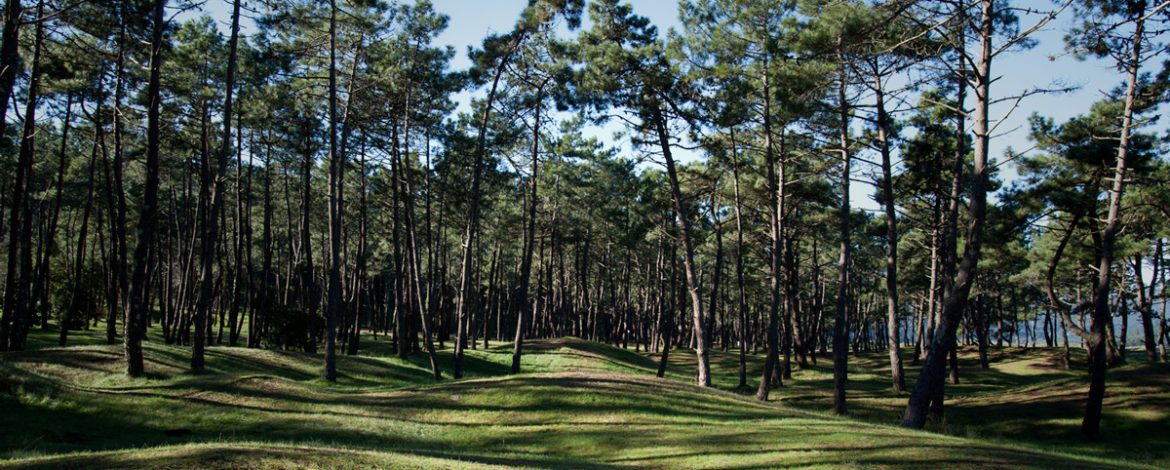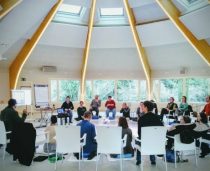The program had different presentations: we learned about the experience of forest management in Finland by one of our volunteers, in addition, Josu Acasuso from Otsaren taldea It brought us a little closer to the biodiversity of Zalla “because you cannot love what you do not know.” We also had the opportunity to view the documentary that this environmental group recorded with its own means. “ Under the fog and on it Zalla is biodiverdsity “. Inesa Banos Onaindia , member of Amalurra and a graduate in Environmental Sciences, she focused her presentation on the importance of maintaining our native forests as an alternative to the pests that live in our conifers and provided some information on this. The theme, around the management of our forests, generated a debate on the balance between economic and ecological objectives where we could also hear the voice of our neighbors and landlords whose role is essential for the maintenance of the ecosystem. The day continued with a didactic walk through the Amalurra forests and a delicious meal based on products from our garden.
We want to share some of the data from Inesa Baños’ presentation to reflect on the landscape we want and the emphasis that environmental policies should adopt in our territory:
Why do we talk about forests today?
- Because they are our wealth.
- Because of its ecological, cultural and economic importance.
- Due to the need for sustainable management.
- So that our future generations can enjoy and have this resource available.
- Because current logging models are coming to an end.
The use of Eucalyptus globulus
• Bizkaia and Gipuzkoa especially and to a lesser extent in Araba and Nafarroa.
• Basque Country: municipalities with the highest number of hectares planted Karrantza (300 hectares) and Artzentales (270 hectares).
• Forest harvesting is currently highly mechanized with “processors” and “skidders”.
• Applications:
- Agricultural economic resource.
- Source of raw material for the forestry industry.
- Processing and pulp industries (cardboard – Amazon).
• Effects on ecosystems:
– They are unable to host species that need mature trees (birds)
– They are much poorer in diversity
– They consume significant amounts of water, due to their high evapotranspiration rate. Dries up rivers and streams.
– Acidify the soil and impoverish the upper layer of the soil.
The use of Pine insignis / Monterrey pine
- North America 100 years ago.
- It has generated a landscape that has become very familiar to us, being, however, a relatively modern landscape.
• In Bizkaia and Gipuzkoa especially and to a lesser extent in Araba and Nafarroa.
• The plantation is subsidized.
• Applications:
– Economic-agricultural resource.
– Source of raw material for the forestry industry.
– Paper pulp and transformation industries.
THE “BROWN BAND” AND THE “E” FOR EUCALYPTUS
• Disease (fungus) of the Pinus insignis Lecanosticta acicola or brown band.
• It expands from the coast towards the interior and devastates extensive masses of pine forests. This fungus is affecting “very virulently” and shows an “unknown” expansive behavior.
- – 54% of the CAPV territory is occupied by pine wooded area
- – 2 months is the period that passes between the needles -needles- becoming infected and falling off. Infected spores are spread by the wind.
• What has been done so far?
1.- Try to cure the plague.
2.- Find candidate species to replace the pine insignis with similar silvicultural and technological characteristics.
3.- Select and vegetatively propagate resistant insignis pine individuals (genetically modify them).
4.- The fourth alternative for private managers begins with the letter “E” for Eucalyptus.
What do forestry experts say? •
“… Pests are a reflection of the monoculture management that has been carried out in the forestry world of the BAC ….”
“… It seems we haven’t learned our lesson. Monoculture tree plantations are a danger in themselves as is happening right now before our eyes. And if we talk about eucalyptus, the blindness is even greater … ”
What can we do?
– Plant our species (chestnut, oak, beech, birch, alder, holm oak, ash, walnut etc …).
– Let the forest repopulate naturally.
• Both alternatives do not receive public aid while the eucalyptus plantations. Can we change this?
• The choice of each species should respond to technical criteria and adapt to each terrain. The planting and use of the stands should in any case respect waterways, public roads, distances to homes …
• Some adult stands of insignis pine have great ecological value and should be protected, being the purchase the most appropriate measure. More than one will be shocked by this proposal, but a large number of raptors (kites, buzzards, booted eagles, alcotanes …) nest in their glasses.
• Support to Associations such as LURGAIA (http://www.lurgaia.org/) or Kolore Gutzietako Basoak (koloreguztietakobasoak.wordpress.com), among others, for the conservation of biodiversity and the management of the natural environment.




